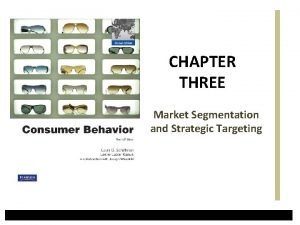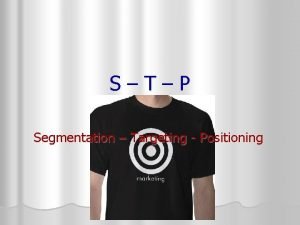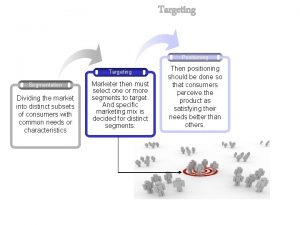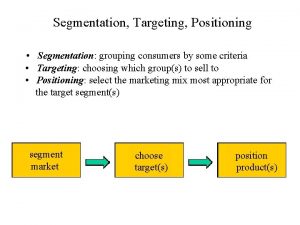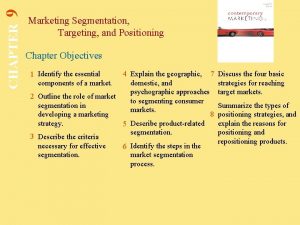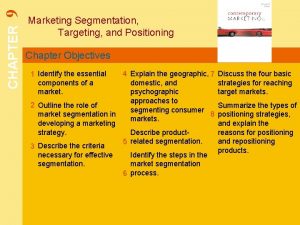CHAPTER 9 SEGMENTATION TARGETING AND POSITIONING 9 1





































- Slides: 37

CHAPTER 9 SEGMENTATION, TARGETING, AND POSITIONING 9 -1 Copyright © 2016 Mc. Graw-Hill Education. All rights reserved. No reproduction or distribution without the prior written consent of Mc. Graw-Hill Education.

Segmentation, Targeting, and Positioning LEARNING OBJECTIVES LO 1 LO 2 LO 3 LO 4 LO 5 Outline the different methods of segmenting a market. Describe how firms determine whether a segment is attractive and therefore worth pursuing. Articulate the difference among targeting strategies: undifferentiated, concentrated, or micromarketing. Determine the value proposition. Define positioning, and describe how firms do it. 9 -2

Netflix AF archive/Alamy 9 -3

Segmentation, Targeting, Positioning Process Step 1 • Strategy or Objectives Segmentation Step 2 • Segmentation Methods Step 3 • Evaluate Segment Attractiveness Targeting Step 4 • Select Target Market Step 5 • Identify and Develop Positioning Strategy Positioning 9 -4

Step 1: Establish Overall Strategy or Objectives Check Yourself Derived from mission and current state ©M. Hruby. 9 -5

Step 2: Segmentation Methods 9 -6

Geographic Segmentation ©Imagine. China 9 -7

Demographic Segmentation Most common segmentation strategy ©Stockbyte/Getty Images U. S. Census Bureau 9 -8

Google’s Project Glass https: //www. youtube. com/watch? v=v 1 uy. QZNg 2 v. E 9 -9

Psychographic Segmentation Psychographic Self-values Self-concept Lifestyles ©Benetton Group SPA; Photo by: Oliviero Toscani 9 -10

VALS Framework VALS 9 -11

Geodemographic Segmentation Source: The Nielsen Company, Nielsen PRIZM 2009. Claritas 9 -12

State Farm Not Insuring Mississippi 9 -13

Benefit Segmentation ©image 100/Punch. Stock Michael Hevesy/Photodisc/Getty Images 9 -14

Behavioral Segmentation Occasion segmentation Royalty-Free/CORBIS Loyalty segmentation 9 -15

CHECK YOURSELF 1. What are the various segmentation methods? 9 -16

Step 3: Evaluate Segment Attractiveness Substantia l Identifiable Reachable SEGMENT ATTRACTIVENESS Profitable Responsiv e 9 -17

Identifiable § Who is in their market? § Are the segments unique? § Does each segment require a unique marketing mix? Liquidlibrary/Dynamic Graphics/Jupiterimages Comstock Images/Jupiter. Images 9 -18

Substantial § Too small and it is insignificant ©Jerry Arcieri/Corbis § Too big and it might need it’s own store 9 -19

Reachable Know the product exists Understand what it can do ©Digital Vision/Punch. Stock Recognize how to buy 9 -20

Responsive Customers must: React positively to firm’s offering Move toward the firms products/services Accept the firm’s value proposition 9 -21

Profitable 9 -22

Profitable Segments § Segment size = 60 million (<15 yrs) § Segmentation Adoption Percentage = 35% § Purchase Behavior = $500 x 1 time purchase § Profit margin % = 10% ©Comstock/Punch. Stock Is this segment profitable? § Fixed Cost = $50 M 9 -23

Step 4: Selecting a Target Market § Conde Nast has more than 20 niche magazines focused on different aspects of life. ©M Hruby 9 -24

Segmentation Strategy Differentiated Undifferentiated or mass marketing Targeting Strategies Concentrated Micromarketing or one-to-one 9 -25

Step 5: Develop Positioning Strategy Positioning Methods • • Value Salient Attributes Symbol Competition Photo by Tiffany Rose/Wire. Image/Getty Images 9 -26

Circles for a Successful Value Proposition No Overlap with Competition Competitive offering The value proposition Customer needs and wants Company offering 9 -27

Circles for a Successful Value Proposition Determining the Value Proposition #1: Firm’s value proposition. #2: Customer’s unmet needs (marketing opportunity). Competitor benefits #3: Firm’s benefits that are not required educate customer or redesign product. #7 #5 #4: Key benefits that both the firm and competitor provide that customers require - carefully monitor performance relative to competitor on these benefits. #6 #4 Customer needs #2 #1 Firm benefits #3 #5: Competitor’s value proposition monitor and imitate if needed. #6: Benefits both firms provide that customers do not appear to need. #7: Competitor benefits that are not required. 9 -28

Positioning Green Giant for Business Wire via Getty Images 9 -29

Positioning Steps 1. Determine consumers’ perceptions and evaluations in relation to competitors’. 2. Identify the market’s ideal points and size. 3. Identify competitors’ positions. 4. Determine consumer preferences. 5. Select the position. 6. Monitor the positioning strategy. 9 -30

Dimension 2 Perceptual Maps Dimension 1 9 -31

Perceptual Maps Contemporary BMW Cadillac Style Buick Ford Kia Toyota Traditional Low Price High 9 -32

Perceptual Maps Contemporary Style Target Market Size indicated By size of circle Traditional Low Price High 9 -33

Perceptual Maps Contemporary BMW Cadillac Target Market Size indicated By size of circle Style Buick Ford Kia Toyota Traditional Low Price High 9 -34

Perceptual Maps Contemporary BMW Cadillac Target Market Size indicated By size of circle Style Buick Ford Kia Toyota Traditional Low Price High 9 -35

Perceptual Maps 9 -36

CHECK YOURSELF 1. What is a perceptual map? 2. Identify the six positioning steps. 9 -37
 Global marketing segmentation
Global marketing segmentation Nivea market segmentation
Nivea market segmentation Sony market segmentation, targeting and positioning
Sony market segmentation, targeting and positioning Segmentation targeting differentiation and positioning
Segmentation targeting differentiation and positioning Sony market segmentation, targeting and positioning
Sony market segmentation, targeting and positioning Nokia target market
Nokia target market Southwest airlines
Southwest airlines Psychographic segmentation of nivea
Psychographic segmentation of nivea Market segmentation objectives
Market segmentation objectives Market segmentation, targeting and positioning
Market segmentation, targeting and positioning Segmentation targeting and positioning of colgate
Segmentation targeting and positioning of colgate Benefits sought segmentation
Benefits sought segmentation Segmentation targeting differentiation and positioning
Segmentation targeting differentiation and positioning Differentiated undifferentiated and concentrated marketing
Differentiated undifferentiated and concentrated marketing Segmentation targeting positioning
Segmentation targeting positioning Global segmentation targeting and positioning
Global segmentation targeting and positioning International positioning strategies
International positioning strategies Market segmentation and targeting ppt
Market segmentation and targeting ppt Marketing segmentation and targeting
Marketing segmentation and targeting Segmentation bases
Segmentation bases Market targeting
Market targeting Hcp segment
Hcp segment Stp in rural marketing
Stp in rural marketing Three market segmentation strategies
Three market segmentation strategies Strategie positioningu
Strategie positioningu Ppt segmentasi targeting positioning
Ppt segmentasi targeting positioning Resume jurnal
Resume jurnal Jurnal internasional segmenting, targeting, positioning
Jurnal internasional segmenting, targeting, positioning Chapter 10 positioning transfers and ambulation
Chapter 10 positioning transfers and ambulation Chapter 11 positioning moving and lifting
Chapter 11 positioning moving and lifting Brand positioning bull's eye
Brand positioning bull's eye Joint targeting cycle
Joint targeting cycle Mktg 8
Mktg 8 Targeting strategy
Targeting strategy Polygon targeting
Polygon targeting User status segmentation examples
User status segmentation examples Concentrated targeting
Concentrated targeting Concentrated targeting
Concentrated targeting























